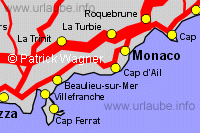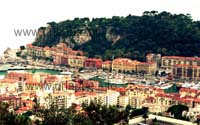|
|
Places between Monaco and Nice
Most of the tourists who are on tour alongside the Côte d'Azur start in Monaco, drive on one of the 3 Corniches and have their next stop at Nice. They see the small places between Monaco and Nice either from above or drive rapidly through them; While a stop in the mountain village Eze belongs to the standard programe, many people miss the wonderful bathing resorts Beaulieu-sur-Mer and Villefranche. The place La Turbie must not be seen, but the column of victory should be seen at least from a distance. La TurbieThose who drive at the very top of the mountain from Menton to Nice will pass La Turbie. Here, one of the most imposing buildings that remains from the time of the Imperium Romanum wait for the visitor. 
By the turn of the era, the Romans already settled in numerous areas of the Côte d'Azur. But the Ligurians who were spread in the Alp valleys made the life of the Romans difficult from time to time. In the 6 B.C., the Ligurians were finally beaten by the Romans. In memory to this, the huge column of vistory was arranged (also called Trophée des Alpes genannt). La Turbie is located at the Via Aurelia, the former trade road that led into the west. The column of victory was set on a base of an edge length of 40 m. Today, the monument measures some stately 35 m. But at that time, it measured not less than 50 metres! But this victory column was not only built in the honour of the Emperor Augustus; it was also supposed to be a clear sign for the occupation of the Romans and for the security of the trade road. 
In the course of the milleniums, the building got very strained and was even rebuilt to a castle complex. Ludwig XIV. even wanted to blast it. It was not begun with the true to original-reduction of the original building until the 20th century. Today, a museum is located at the bottom of the monument at which one can look at the true to original-reduction of the original monument. A visit of La Turbie and its huge Roman monument is not only worthwhile because of the massive volume of the building. La Turbie also has a very nice oldtown that is really worthwhile to see. Those who view the Roman monument will be rewarded at the same time with a fantastic view to Monaco. There are only a few spots at the Côte d'Azur that offer from a height of nearly 500 m such a powerful view downwards with such a big coulisse of houses. Cap d'AilThe Garlic-Cape is quite unspectacular, the Cap d'Ail. Those who are not experiencing a performance of the open-ir theatre of this small place, will not find many interesting things in the Cap d'Ail. But there is a small hiking path, a sentier touristique, that still offers something attractive which are fantastic views to a long extended bay up to the Cap Ferrat at the front, as also a small, nice and cozy bathing beach. Beaulieu-sur-Mer - A Gorgeous Bathing ResortThose who come from Menton and/or Monaco and drives alongside the coastal road to Nice will cross, not far from von Nice, the small bahing resort Beaulieu-sur-Mer. Only a few tourist do a stop in the traditional bathing resort; the metropolis Nice is much too attractive. But thereby, all these passing-through drivers miss this wonderful place with one of my favourite beaches of the Côte d'Azur. 
Beaulieu-sur-Mer is located at the golf of Saint-Hospice and has an own small bay, the Baie des Fourmis (bay of ants)Don't worry, there are no more ants here than somewhere else. But the bay offers a dream beach in a way that cannot be more inviting: the beach area is separated by some plams from the boardwalk. The beach consists on tiny pebbles; they are so small that they are smooth as sand but still they are not blowed by the wind into one's face. Laying on this dream beach, one cannot help but repeatedely play with the pearly pebble. At the eastern end of the ants bay there is the Villa Kérylos. This dream villa in Greek style was made built by the Baron Reinach, a relative of the Rothschilds, in the year 1902. Money was not a matter in the case of building this palace; by this way, only the most precious materials were applied. The villa stands on a complex that comprehends more than 2500 m². For more than 6 € entrance, one can view the greek building with the atrium. 
For those who like to view some villas and dream houses, I recommend a walk on the Promenade Maurice Rouvier up to Saint-Jean-Cap-Ferrat. In a good hour, one passes a lot of pompous villas. But the view to the sea and back to the bay is at least as beautiful. The modern marina of Beaulieu is also impresssive: more than 800 boats and yachts are located at this spot at the eastern end of the place. Even those who only drive through Beaulieu-sur-Mer will probably discover the two grandhotels Métropole and Réserve and wonder why in a place with less than 5.000 people there are so luxurious accommodations. By the end of the 19th century, Beaulieu-sur-Mer developed to one of the most posh bathing resorts at the whole of the Côte d'Azur. Numerous rich businessmen and fabricants, but also coronated aristocrats spent the winter in Beaulieu-sur-Mer; As the place in located at a well protected bay, Beaulieu-sur-Mer the second most pleasant climate of the Côte d'Azur (the first one is Menton). The proximity to the metropolis Nice of course makes this place even more attracive. Moreover, Beaulieu-sur-Mer has a small casino where one can get rid of the money. For me, Beaulieu-sur-Mer belongs to those places that I visit any time I am at the Côte d'Azur. The beach is simply much too beautiful! A further small tip for the beach visitor: at the beach, the food and beverages are sold to unbelievably high prices; this is an absolute extortion! Those who walk a few hundred metres will find a kiosk at the end of the promenade that offers better stuff for half of the price. Cap FerratWhich is the most posh place of the whole Côte d'Azur? This question cannot be clearly answered, but the question of which are the two most posh places can be rapidly answered: it is the Cap Ferrat at Nice and the Cap Martin between Menton and Monaco. While there is a hectic passing-by trffic through all coastal places, these two capes are excluded of it; except some tourists of the peninsula, there is barely somebody coming to these posh places. 
Amidst the 19th century, the Cap Ferrat was a nice and nearly untouched piece of nature; Not until some famous persons, thereunder the Belgian King, bought real estates on Cap Ferrat, the peninsula that extends 3,5 km into the sea developed to an absolute hideaway for the most rich ones in the world. Those who visit today the Cap Ferrat can often only perceive the opulent richness: huge villas are surrounded by gardens that are partly bigger than the land surface of some German agriculturists. Most of the gardens are protected against the curious views of the poor tourists by some white walls of several metres height. One gets the most from the pompous villas by going around the cape by foot. The tour that is a little more than 10 kilometres long is done in two good hours if one does not make too many stops because one cannot believe his eyes. The Cap Ferrat not only offers views to the pompous buidings and posh villas but also some unique distance views to the west to the Baie des Anges up to the Cap d'Antibes and at the east to the Golfe de St.-Hospice up to the rock of Monaco. Those who want to look into the interior of one of the many luxurious villas in Cap Ferrat can get for an entrance fee of 10 € into the biggest and most traditional viewing: the museum Ephrussi de Rothschild. At the beginning of the 20th century, Madame Béatrice Ephrussi de Rothschild made built a villa in Venetian style on an estate of seven hectares like no other. I wonder if people can live at all in such a huge house or if it was right away considered to be a museum in order to demonstrate in an impressive way the richness of the family Rothschild. In the interior of the villa one sees valuable paintings, sculpures, carpets and furniture. Much more impressive than the arrangement of the interior are the different garden complexes that surround the villa; Each single garden has its own style: from the traditional French garden up to an exotic Japanese garden, there is almost anything available what the international gardeners have to offer. As the villa Rothschild is located at the very top of the cape, one has in addition some wonderful views to the sea and to the land. At the east coast of the cape there is the little village Saint-Jean-Cap-Ferrat. The a little more than 2.000 inhabitants of the village remained mainly untouched by the mass tourism, so that the place could keep its old flair and its chracter as a fisher village. Of course, in Saint-Jean-Cap-Ferrat, all the modalities of the island millionaires are settled, but as a tourist one barely notices this, only when from time to time, a posh car passes by. Villefranche-sur-MerBy driving from Nice in eastern direction, after barely leaving Nice one is already in Villefranche. The small place counts barely 10.000 inhabitants, but they live at different heights: the place begins right at the sea and extends some several hundred metres up to the Mont Alban. 
In medieval times, Villefranche-sur-Mer belonged to the county Savoyen and was not returned to France together with Nice until the year 1860. Those who drive through Villefranche will see, if being a little lucky, a huge ocean liner in the huge port basin. These giants do not stop at Nice itself, as the port basin of Nice is not deep enough. But in Villefranche, the biggest ships can let go anchor with a huge draught. Due to this reason, Villefranche served after the Second Worldwar as a base of the American marine. The most worthwhile seeing of Villefranche-sur-Mer ist is, in fact, the port basin with its enourmos volume. Sometimes, this huge bath tube swarms with yachts. The small core of the oldtown is, thanks to its Chapele Saint-Pierre, worthwhile seeing. Interesting is also the medieval street Rue Obscure, on which one does not get wet even if its raining: it is almost completely roofed. 



Copyright: Patrick Wagner, www.tourist-guide.biz |
||